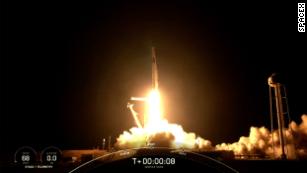SpaceX just brought the first all-tourist crew back from space. Here’s what’s next

Four passengers strapped themselves into a SpaceX capsule atop a 200-foot-tall rocket and made a three-day spin around Earth, all of whom had no formal spaceflight training just six months earlier. The occupants emerged from their capsule, happy and waving, albeit a little shaky after over 72 hours in weightlessness, off the coast of Florida on Saturday. It’s only the beginning, according to SpaceX.

The crew included Jared Isaacman, 38, a businessman who financed the journey directly; Hayley Arceneux, 29, a childhood cancer survivor and physician assistant at St. Jude Children’s Research Hospital; Sian Proctor, a 51-year-old geologist, and professor, and Chris Sembroski, 42, a Lockheed Martin employee and lifetime space fan who won his seat through an online raffle.
Related: SpaceX capsule returns four civilians from orbit, capping off first tourism mission

The tourism mission, dubbed Inspiration4, that ended on Saturday was far from the first time that people who do not identify astronauts as their day job have traveled to space. A group of affluent thrill-seekers paid their way aboard the International Space Station in the 2000s, using Russian Soyuz rockets. Richard Branson, the millionaire founder of Virgin Galactic, and Jeff Bezos, the founder of Amazon, each took a brief trip to suborbital space aboard spacecraft manufactured by their respective firms in July.
It was an inspiration4 journey, however, as the first time SpaceX was on a wholly private trip to floating on one of its Crew Dragon spacecraft. Astronauts from and to the International Space Station were planned to ferry by NASA to the Dragon Spacecraft Crew.
More such missions for SpaceX’s Crew Dragon are on the way, with five already contracted for other groups of tourists to fly in the months and years ahead. The business is currently working on its “Starship” vehicle, which will be the most powerful rocket and spacecraft combo ever launched. Yusaku Maezawa, a Japanese millionaire, has also scheduled a journey around the moon on that rocket, which NASA may use for its lunar landing plans.
SpaceX’s goal is to make interplanetary travel more common so that, if and when extraterrestrial hotels and manufacturing facilities are built in Earth’s orbit, outer space becomes more accessible to the general public. Space tourism could one day help SpaceX achieve its grandiose goal of colonizing Mars.
Inspiration4 and similar space tourism projects have already sparked disputes over what to call humans who travel into space. They’re astronauts, right? Are such expeditions truly “for everyone,” or will they just be available to the ultra-wealthy and a select few? Should we even be dreaming of living and working in space while humankind is grappling with so many pressing problems on Earth?
Inspiration4’s actions — and inactions

According to US government data on the cost of a Crew Dragon capsule, Inspiration4 likely cost many millions of dollars. Isaacman told Axios that the sum was “less than $200 million,” but he didn’t elaborate.
That means Inspiration4 is still a long way from ushering in a period when space travel is truly accessible to all. And this created anxieties that the wealthy will create the future of space flight, transforming space from the marvel that mankind spent many years contemplating the rich.
In a recent interview with CNN Business, Isaacman addressed the issue, saying that his primary purpose with Inspiration4 was to, well, inspire. That’s why he paired the mission with fundraising for St. Jude Children’s Research Hospital, which, owing to SpaceX CEO Elon Musk’s $50 million grant, exceeded its goal of $200 million.
Related: How to practice religion could be a big question for some space tourists
And the mission provided Isaacman with a platform. Last week’s Inspiration4 debut drew over 3 million viewers, with millions more tuning in for the splash-down return. Twitter was swamped with both loving and disparaging postings about their adventure.
Timiebi Aganaba, an Arizona State University professor who studies space ethics and law, said the outpouring is an indication of the inherent difficulty of contemplating humanity’s future in space.
She said “It’s hard for me because I’m also a member of the Space Enthusiasts Group. “However, I suppose I’m a little more practical.” Inspiration4 appears to be a once-in-a-lifetime event. It occurred sparked by a discussion between two billionaires” — Isaacman and Musk — “and it was still a fantastic marketing opportunity.”
She went on to say that it’s easy to be inspired by the thought that four strangers with little to no experience in spaceflight have the courage to strap themselves to the top of a rocket despite the various risks that such an expedition entails.
Aganaba admitted that, beyond the thrill of spaceflight, she has wrestled with the topic of how much emphasis — and resources — When people throughout the world “dying, emaciated and hungry,” we should put on spatial travel.
Despite this, she continues to encourage people to pay attention and develop an interest in space and what we should be doing there.
“It will take her to wherever she ends if she can transcend over and perceive something else.”
What comes next?
SpaceX is the poster child of a new era in space exploration, in which corporations, not governments, take the lead. The concept is that the private sector can stimulate innovation while also lowering prices.
Hundreds of other businesses share similar goals. Virgin Galactic, founded by Sir Richard Branson, and Blue Origin, founded by Jeff Bezos, are working to make suborbital joy rides, which are substantially less expensive than orbital trips but still cost over a quarter of a million dollars, a common occurrence.
On the orbital side, a Houston-based business called Axiom. Which is founded by a former NASA executive, has already scheduled four private citizen trips to the ISS with SpaceX. The firm also claims to be working on the world’s first commercial space station.
Space Adventures, the business behind the early 2000s Russian-provided tourism missions, has also booked a voyage with SpaceX. It’s also scheduled a journey on a Russian Soyuz rocket for Japanese billionaire Yusaku Maezawa. The same guy who booked the moon mission on SpaceX’s Starship — in December 2021.
There are plans to record a few reality television shows, one of which will be a competition series that will send the victor into space, and another in which MMA fighters would compete in microgravity. Tom Cruise, who spoke with the Inspiration4 crew over the phone during their mission, also has plans to film a film on the ISS.
Hundreds of other firms are announcing ideas for projects like space manufacturing, space hotels, and flying people up in enormous balloons.
It remains to see whether or not those plans come to fulfillment. There have been significantly more failures than successes in the history of private space travel. Getting goods to space is still prohibitively expensive, and space travel poses a significant risk. If just one mission fails, whether it’s a NASA mission or a commercial mission, it could cripple the industry for years.
Space tourism, in particular, does not appear to be a mass-market industry, according to Aganaba.
“People chanting, ‘Everyone is going to space!’ last year were a tad over the top… Is it necessary for everyone to travel to space?” she stated “Not everyone needs to climb Mount Everest.”
Leave a Reply
You must be logged in to post a comment.